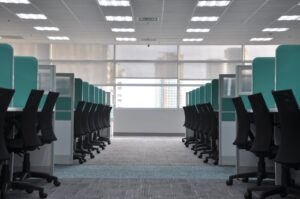 As workers return to the office, collaboration spaces are getting a makeover. With hybrid work becoming the norm, workspaces need to be redesigned. As PwC describes it, “Future workplaces will be where people, technology, and processes can integrate seamlessly to enable highly productive work. It will be a place of instant and seamless flow between the physical and virtual workplaces.”
As workers return to the office, collaboration spaces are getting a makeover. With hybrid work becoming the norm, workspaces need to be redesigned. As PwC describes it, “Future workplaces will be where people, technology, and processes can integrate seamlessly to enable highly productive work. It will be a place of instant and seamless flow between the physical and virtual workplaces.”
A major change for most workspaces will be enabling increased video and teleconferencing to account for the growing number of remote workers. According to Sensor Tower, videoconferencing app usage surged during the pandemic with high consumption continuing even as in-person spaces reopen. As the OECD notes, “Widespread telework may remain a permanent feature of the future working environment, catalysed by the experiences made with teleworking during the COVID-19 crisis.”
Successful videoconferencing requires the right technology solutions, from hardware to teleconferencing apps and collaboration platforms. In addition to deploying the right technology, there are other important considerations for configuring video collaboration spaces. This includes the consideration of windows and natural lighting, where to position furniture, and what microphone placement will work best in a particular space.
1. Maximising interiors
Fine-tuning interiors to enhance the environment, considering how everything from flooring and soft furnishings affect the acoustics, is vital to creating the most productive space.
- Window treatments: many offices overlook busy roads and construction sites, where noise can be significantly distracting, particularly through single glazing. Curtains and draperies should be heavy enough to dampen sound from inside and outside the room.
- Floor materials: hardwood and tile floors can be problematic for echo and acoustic levels – ideally, carpet should be installed for sound dampening. Research shows that better audio quality improves speaker perception, while ambient and background noise increases stress levels.
- Lighting levels: brighter lighting improves clarity and focus, particularly for people’s faces. With visual cues being lost in virtual meetings, optimising video quality is critical. Poor quality video and audio results in higher “Zoom fatigue”.
To further minimise background noise, acoustic fence technology can be used to block out distractions and prevent unwanted sounds being picked up during a meeting. For example, Acoustic Fence with Beam Shaping Technology uses a defined beam to limit sounds outside of the beam area.
2. Configuring the room layout
The most effective room layouts provide the right audio and visual between all participants, whether just two people or twenty. This involves more careful configuration than hanging a display and setting up a conference table and chairs.
- Different room sizes: the choice of technology solution will depend on the room size. For example, larger conference rooms will need different cameras and more microphones than small huddle rooms.
- Mount cameras correctly: webcams are best placed near the horizontal and vertical centres of a display. Ideally, the camera is best positioned close to eye level or slightly above.
- Consider distance: microphones have a specific range that a speaker needs to be within for optimal audio quality. For larger spaces, multiple microphones should be considered to extend the range and allow for audio pickup in other areas of the room.
3. Optimising collaboration experiences
Successful virtual collaboration is also about the culture of an organisation and integrating different work styles. Attracting workers back to the office can be challenging. But work has changed forever, and workspace design needs to reflect that. Ignoring employee expectations is unwise at a time when there is a severe talent shortage, and the power balance has tipped towards jobseekers.
The office of the future will be more about providing a place for tasks that cannot successfully be done remotely. PwC has identified the “four Cs” – concentration, collaboration, communication, and contemplation, with businesses needing to find a balance between offering the right amount of each space type.
People also have different preferences when it comes to apps and technology, which can cause confusion or even security issues. Some messaging platforms, for example, are more secure than others. Organisations need to balance usability with security and have technology policies that are flexible, practical, and secure enough to enable individual user preferences where possible.
Above all, the most important factor when designing tomorrow’s workplaces is equity: ensuring that everyone is able to participate equally, no matter where they choose to work from.
By Bill Zeng, Senior Director of Poly in the Asia-Pacific
